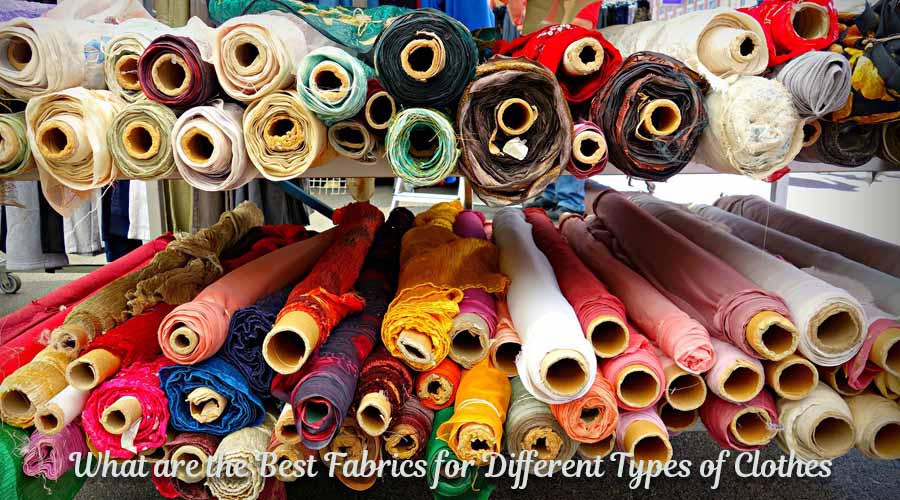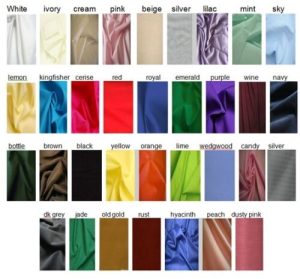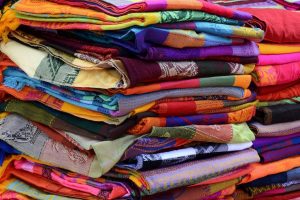
What are the Best Fabrics for Different Types of Clothes
What are the Best Fabrics for Different Types of Clothes?
Introduction
Clothing is an essential part of our daily lives and helps to protect us from the elements. The type of fabric used to make a garment can have a significant impact on its comfort, durability, and appearance. Choosing the right fabric for a particular type of clothing can make all the difference in ensuring that the garment is suitable for its intended purpose and meets the wearer’s expectations.
In this blog post, we will explore the different types of fabrics available and discuss the best fabrics for different types of clothing. From natural fibers such as cotton and silk to synthetic fibers like polyester and nylon, we will look at the properties and suitability of each fabric for various types of clothing.

Natural Fibers
Cotton
Cotton is a natural fiber that is soft, breathable, and lightweight. It is one of the most commonly used fibers in the world, due to its versatility and affordability. Cotton is also easy to dye, making it a popular choice for a wide range of clothing styles.
Characteristics and Properties:
- Soft and comfortable to wear
- Breathable and lightweight
- Absorbs moisture easily
- Easy to dye
- Affordable
Suitability for Different Types of Clothing:
- T-shirts and other casual wear
- Underwear and lingerie
- Summer dresses and skirts
- Jeans and casual pants
Linen
Linen is a natural fiber that is strong, absorbent, and has a distinctive texture. It is often used in the summer due to its lightweight and breathable nature, but can be prone to wrinkling.
Characteristics and Properties:
- Strong and durable
- Absorbent and breathable
- Distinctive texture
- Prone to wrinkling
Suitability for Different Types of Clothing:
- Summer dresses and skirts
- Linen pants and shorts
- Lightweight jackets and coats
Silk
Silk is a luxurious natural fiber that is soft, smooth, and has a glossy appearance. It is often used in high-end fashion due to its sophisticated look and feel, but can be delicate and expensive.
Characteristics and Properties:
- Soft and smooth
- Glossy appearance
- Luxurious and sophisticated look
- Delicate and expensive
Wool
Wool is a natural fiber that is warm, insulating, and has a soft texture. It is often used in colder weather clothing due to its ability to keep the wearer warm and comfortable.
Characteristics and Properties:
- Warm and insulating
- Soft texture
- Breathable and moisture-wicking
- Fire-resistant
Suitability for Different Types of Clothing:
- Winter coats and jackets
- Scarves, hats, and gloves
- Sweaters and cardigans
- Blankets and throws
Synthetic Fibers
Synthetic fibers are man-made fibers created from various chemicals and substances. They are widely used in the production of clothing due to their low cost and durability.
Polyester
Characteristics and Properties:
- Durable and long-lasting
- Low cost
- Resistant to wrinkling and tearing
- Quick drying
- Easy to care for
- Low moisture absorption
Suitability for Different Types of Clothing:
- Athletic and outdoor clothing
- Activewear
- Swimwear
- Undergarments
- Casual wear
Nylon
Characteristics and Properties:
- Durable and long-lasting
- Resistant to wrinkles, abrasion, and moisture
- Quick drying
- Low moisture absorption
- Smooth and silky texture
Suitability for Different Types of Clothing:
Nylon
Characteristics and Properties:
- Durable and long-lasting
- Resistant to wrinkles, abrasion, and moisture
- Quick drying
- Low moisture absorption
- Smooth and silky texture
Suitability for Different Types of Clothing:
- Athletic and outdoor clothing
- Activewear
- Swimwear
- Undergarments
- Casual wear
Acrylic
Characteristics and Properties:
- Low cost
- Lightweight and warm
- Resistant to fading, pilling, and stretching
- Quick drying
- Easy to care for
Suitability for Different Types of Clothing:
- Winter coats and jackets
- Scarves, hats, and gloves
- Sweaters and cardigans
- Blankets and throws
Spandex
Characteristics and Properties:
- Elastic and stretchy
- Comfortable and flexible
- Quick drying
- Resistant to fading, pilling, and stretching
Suitability for Different Types of Clothing:
- Athletic and outdoor clothing
- Activewear
- Swimwear

Blends
Explanation of blends and their properties
Blends are fabrics that are made by combining two or more different fibers into a single yarn. These blends are created to take advantage of the unique properties of each individual fiber and can be tailored to meet specific needs. The resulting fabrics often have improved durability, comfort, and performance compared to pure fabrics made from a single fiber.
Cotton-Polyester Blend
Characteristics and properties
A cotton-polyester blend is created by combining cotton and polyester fibers. Cotton is known for its softness, breathability, and natural moisture-wicking properties, while polyester is known for its strength, durability, and resistance to wrinkling and shrinking. Cotton-polyester blends offer a combination of both natural and synthetic properties, making them a popular choice for a variety of clothing items.
Suitability for different types of clothing
Cotton-polyester blends are ideal for making everyday clothing items, such as T-shirts, polo shirts, and casual pants. They are also often used for making athletic wear and workout clothes, as polyester helps to wick moisture away from the skin, keeping the wearer cool and dry. Cotton-polyester blends are also a good choice for bed sheets and towels, as they are durable and can be machine-washed and dried without shrinking or losing their shape.
Wool-Polyester Blend
Characteristics and properties
A wool-polyester blend is created by combining wool and polyester fibers. Wool is known for its natural insulation, warmth, and softness, while polyester is known for its strength and durability. Wool-polyester blends offer a combination of natural and synthetic properties, making them a popular choice for a variety of clothing items.
Suitability for different types of clothing
Wool-polyester blends are ideal for making winter wear, such as coats, jackets, and scarves, as they provide natural insulation and warmth. They are also often used for making dresswear, such as suits and skirts, as the polyester helps to reduce wrinkling and keep the garment looking neat and crisp. However, wool-polyester blends may not be the best choice for very sensitive skin, as polyester can sometimes irritate or cause allergic reactions.
Silk-Polyester Blend
Characteristics and properties
A silk-polyester blend is created by combining silk and polyester fibers. Silk is known for its natural softness, drapability, and lustrous appearance, while polyester is known for its strength and durability. Silk-polyester blends offer a combination of natural and synthetic properties, making them a popular choice for a variety of clothing items.
Suitability for different types of clothing
Silk-polyester blends are well-suited for a wide range of dresswear, such as formal shirts, dresses, skirts, and blouses. They are also a good choice for making lingerie, sleepwear, and activewear as they are lightweight and have a soft, silky texture that feels comfortable against the skin
Conclusion
Recap of Popular Clothing Styles for Different Seasons
In this blog post, we covered the popular clothing styles for spring, summer, fall, and winter. We discussed the key pieces that are essential for each season, such as sundresses and light jackets for spring, flowy tops and shorts for summer, plaid prints and turtlenecks for fall, and coats and jackets for winter.
Final Thoughts
Fashion is a dynamic and ever-changing industry, and it’s important to stay up-to-date on the latest trends. However, it’s also important to remember that trends come and go, and the key to fashion is finding what works for you and makes you feel confident and comfortable. Use these popular clothing styles as a starting point, but don’t be afraid to experiment and try new things.
Encouragement to Try Out New Styles
Whether you’re a seasoned fashionista or just starting to explore your personal style, now is the perfect time to try out new clothing styles for each season. Get inspired by the latest trends, but don’t be afraid to put your own spin on them. Fashion is all about having fun, so have fun and enjoy the process!








